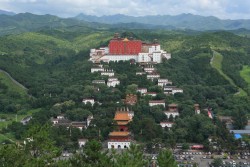

Introducing Jingshan Park
Located just north of the Forbidden City, Jingshan Park is a beautiful imperial garden in Beijing. Jingshan Park was opened to the public in 1928. Covering 23 hectares (57 acres), it is listed as an integral part of the Beijing Central Axis, a UNESCO World Heritage site in 2024. Built on a hill formed from the excavated earth from the construction of the Forbidden City’s moats, the park features five pavilions, each perched atop one of the hill’s peaks, and lush landscaping including ancient trees, flowers, and pathways.
Historically a private imperial garden, Jingshan Park is now a popular public space where visitors can enjoy its historical significance, scenic beauty, and vibrant cultural atmosphere, often featuring traditional activities like calligraphy, kite flying, and opera performances.
Jingshan Park Fast Facts
• Chinese Name: Jǐng Shān Gōng Yuán 景山公园
• Best Time to Visit: All year around
• Recommended Visiting Hours: About 3 to 4 hours
• Things to Do: Photography, Architecture, Hiking
• Opening Hours: 6:00 – 21:00 (Apr – Oct), 6:30 – 20:00 (Nov – Mar), 8:00 – 17:00 (Temples)
• Entrance Fee: CNY2, CNY10 (July 14 – August)
• Address: No.44 Jingshan West Street, Xicheng District, Beijing
What to Expect at Jingshan Park
Escape the city’s clamor and find tranquility in Jingshan Park. High on a hill overlooking Beijing, the park offers stunning views of the Forbidden City spread out below. It’s a beautiful place to connect with nature and history, surrounded by trees and with the palace shimmering in the distance.
The Five Pavilions
The five graceful pavilions of Jingshan Park—Zhoushang, Fulan, Guanmiao, Jifang, and Wanchun—were all constructed in 1750 during the reign of the Qing Dynasty (1644-1912).
Zhoushang and Fulan Pavilions are identical counterparts. These double-eaved, circular structures, capped with pointed roofs, rise to a height of 11.75 meters (38.55 ft). Sunlight shimmers on their vibrant peacock blue glazed tiles, accented with amethyst trim. Similarly, Guanmiao and Jifang Pavilions face one another in harmonious balance. These double-eaved, octagonal pavilions, also with pointed roofs, reach a slightly taller height of 12.05 meters (39.53 ft). A striking contrast is created by their emerald green glazed tiles, offset by warm yellow trim.
The majestic Wanchun Pavilion commands attention from its perch atop the highest point of Jingshan Park. Its location at the midpoint of Beijing’s north-south architectural axis underscores its symbolic importance. The pavilion’s triple-eaved, square structure reaches a height of 15.38 meters (50.46 ft), surpassing its fellow pavilions. The resplendent yellow glazed tiles are edged with green. Intricate, high-grade decorative brackets, complete with gold-accented, dragon-patterned beams, create an aura of imperial majesty.
Qiwang Hall
Once the venue for grand imperial banquets, the impressive two-story Qiwang Hall (Hall of Exquisite View) boasts a double-eaved hip-and-gable roof, resplendent with gleaming yellow glazed tiles and intricate ridge decorations. Inside, the grandeur continues with exquisitely painted beams and rafters, showcasing traditional Chinese decorative motifs and reflecting the hall’s imperial past. A broad, three-tiered marble terrace, bordered by white marble balustrades, stretches out in front of the hall, enhancing its sense of nobility and solemnity. True to its name, ascending to Qiwang Hall reveals a breathtaking panorama of the surrounding landscape, much like reaching a summit to enjoy a stunning view. Today, the hall serves as a cultural exhibition space, displaying calligraphy, paintings, and porcelain.
Shouhuang Temple Complex
The Shouhuang Temple Complex, also known as the Hall of Imperial Longevity, stands as a magnificent testament to Qing Dynasty ancestral worship. This sprawling complex housed the portraits and memorial tablets of eight emperors, ranging from Kangxi (reigned 1661-1722) to Guangxu (reigned 1875-1908), along with those of their empresses. As such, it played a crucial role in imperial rituals. On important occasions like New Year’s Day, the winter solstice, and the anniversaries of the emperors’ births and deaths, the imperial family would gather at the Shouhuang Temple to perform elaborate ceremonies expressing reverence and respect for their forebears.
The Guandi Temple
Enveloped in swirling incense smoke, the imposing two-courtyard Guandi Temple boasts a gleaming yellow glazed tile roof, adorned with ornate dragons and phoenixes. Enshrined within are Guan Yu, the God of War (a revered Chinese military general during the late Eastern Han dynasty), and in the rear hall, Zhenwu Emperor (also known as Xuantian Shangdi, the Great Valiant Deity embodying the Northern Black Tortoise). The temple extols Guan Yu’s loyalty, righteousness, and noble sacrifice, inspiring future generations. Legend attributes the “Loyalty and Righteousness” plaque in the main hall to Emperor Kangxi, further emphasizing the temple’s esteemed status.
Guande Hall
Guande Hall (The Hall of Observing Virtue) was originally built during the Wanli period (1572-1620) of the Ming Dynasty as a place for the emperor to observe archery practice. However, its function changed dramatically during the Qing Dynasty. In 1752, following the death of Empress Xiaoxianchun, the heartbroken Emperor Qianlong ordered the hall rebuilt to house her remains. It became the imperial mortuary (often called the “funeral palace”), where deceased emperors and empresses lay in state until their tombs were completed. To continue governing during the mourning period, Qianlong also constructed the Yongsi Hall (Hall of Eternal Remembrance) next door as a temporary office.
How to Get to Jingshan Park
• By Bus: Take bus 101, 109, 128 to Shenwumen (Shenwu Gate) Station.
• By Subway: Take subway line 8 to Zhongguomeishuguan (The National Art Museum of China) Station.
Additional Travel Advice on Jingshan Park
• Rental services of wheelchair, baby carriage and umbrella are available at the park.
• A peony fair and tulip fair are held in the park every year, usually from April to May.